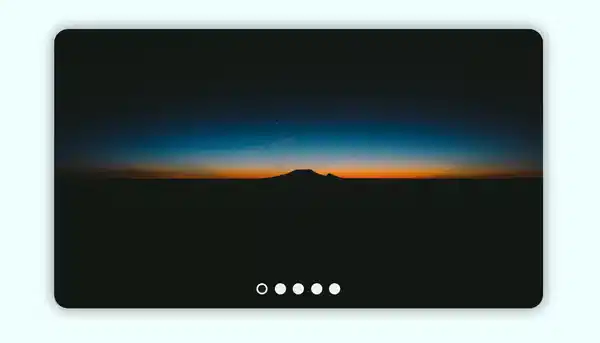使用 JavaScript 的图像滑块
在本文中,我们将创建一个简洁的图片滑块(也称为轮播)。它能够以精彩的动画效果滑动图片,并跟踪当前图片,您可以通过底部的圆点看到当前图片。首先,让我们看看我们要构建什么。
预览
HTML
<div class="container-slider">
<!-- Slider Container with images... -->
<div class="slides"></div>
<!-- Previous Button -->
<button class="btn-slide prev">
<img src="https://imgur.com/SUyRJqI.png" alt="prevBtn" />
</button>
<!-- Next Button -->
<button class="btn-slide next">
<img src=" https://imgur.com/M6rDsRR.png" alt="nextBtn" />
</button>
<!-- Container for dots -->
<div class="container-dots"></div>
</div>
div我们将创建一个带有 类的outer .container-slider。它将有四个独立的子类。
.slides:它将包含图像,但我们还没有在 HTML 中添加它们,我们将使用 JS 添加它们。.btn-slide:在父容器(.container-slider)中将有两个按钮,一个用于下一张图片(.next),另一个用于上一张图片(.prev).container-dots.dot:这是我们尚未添加的容器。它也将像图片一样由 JS 完成。
想必你现在已经大致了解了我们正在做的事情。现在我们开始讨论 CSS。
CSS
* {
margin: 0;
padding: 0;
}
body {
background: azure;
min-height: 100vh;
padding: 0 25px;
}
/* Main Wrapper Container */
.container-slider {
position: relative;
max-width: 700px;
width: 100%;
height: 400px;
border-radius: 20px;
box-shadow: 0 0 20px rgba(0, 0, 0, 0.5);
overflow: hidden;
}
/* Slider Container which contains images */
.slides {
position: relative;
width: 100%;
height: 100%;
}
/* Default Image Properties */
.slides img {
position: absolute;
width: 50px;
height: 50px;
object-fit: cover;
object-position: center;
opacity: 0;
transform: scale(0);
transition: all 0.5s ease-in-out;
transition-delay: 500ms;
}
/* Active Image or Current image to display */
.slides > img[data-active] {
opacity: 1;
transform: scale(1);
transition-delay: 0ms;
width: 100%;
height: 100%;
z-index: 10;
}
/* Image Slider Next And Previous Buttons */
.btn-slide {
position: absolute;
background: #f1f1f1;
width: 40px;
height: 40px;
padding: 10px;
border-radius: 50%;
opacity: 0;
border: 1px solid rgba(34, 34, 34, 0.287);
transition: opacity 300ms ease-in-out;
cursor: pointer;
overflow: hidden;
z-index: 10;
}
.btn-slide > img {
width: 100%;
}
/* Show Buttons when user hover on the slider Container */
.container-slider:hover > .btn-slide {
opacity: 1;
}
/* Previous and Next Button Position Absolute */
.prev,
.next {
top: 50%;
transform: translateY(-60%);
}
.prev {
left: 20px;
}
.next {
right: 20px;
}
/* Bottom Dots Container */
.container-dots {
position: absolute;
bottom: 20px;
width: 100%;
display: flex;
justify-content: center;
z-index: 10;
}
/* Sigle Dot style */
.dot {
width: 10px;
height: 10px;
border-radius: 50%;
border: 3px solid #f1f1f1;
margin: 0 5px;
background: #f1f1f1;
cursor: pointer;
transition: background-color 500ms ease-in-out;
}
/* Change the color of bg when user hover on it. */
.dot:hover {
opacity: 0.9;
background: rgb(32, 32, 32);
}
/* Current or active dot */
.dot[data-active="true"] {
background: rgb(32, 32, 32);
}
CSS 中的所有内容都是不言自明的,所以我就不多说了。如果你对 CSS 有任何疑问,请在下面留言。
JavaScript
好戏就此开始。让我们从头开始看看。首先,我们需要导入两个容器,分别是. Slides和. Container-dots。
const slides = document.querySelector(".slides");
const containerDots = document.querySelector(".container-dots");
现在我们需要将图片添加到.slides容器中。我们还需要一个全局计数器或全局索引来跟踪当前正在显示的图片。
// Global Index to track Image
var slideIndex = 1;
// Images container
const images = [
{ src: "https://rb.gy/ohx0bd" },
{ src: "https://rb.gy/gggxy8" },
{ src: "https://rb.gy/z2a0fy" },
{ src: "https://rb.gy/nsefjh" },
{ src: "https://rb.gy/dssu2a" }
];
现在我们有了图像,现在让我们把它们添加到 中,.slides并且我们还需要将它们添加.dot到 中.container-dots。图像总数和点总数应该相同,例如,有五幅图像,那么就应该有五个点。让我们看看该怎么做。
// Adding images and dots to the Respective Container
images.map((img) => {
// Creating Image Element and adding src of that image
var imgTag = document.createElement("img");
imgTag.src = img.src;
// Creating Dot (div) Element adding 'dot' class to it
var dot = document.createElement("div");
dot.classList.add("dot");
// Appending the image and dots to respective container
slides.appendChild(imgTag);
containerDots.appendChild(dot);
});
它会完成这个任务,并将它们添加到各自的容器中。现在我们需要按钮添加到滑块中。我们也来做一下。我们需要两个按钮.prev,.next我们已经将它们添加到 HTML 中,现在只需让它们工作即可。
下一张幻灯片按钮
// Slide Next Button Click Event
const nextSlide = () => {
// it will update the slideIndex on the basis of the images.length as it gets greater than images.length, this will initialize to the 1
if (slideIndex !== images.length) {
++slideIndex;
} else if (slideIndex === images.length) {
slideIndex = 1;
}
};
const nextBtn = document.querySelector(".next");
nextBtn.onclick = nextSlide;
上一张幻灯片按钮
// Slide Previous Button Click Event
const prevSlide = () => {
// It will check if the slideIndex is less equal to 1 then change it to the images.legnth, it will enable infinite scrolling
if (slideIndex !== 1) {
--slideIndex;
} else if (slideIndex === 1) {
slideIndex = images.length;
}
};
const prevBtn = document.querySelector(".prev");
prevBtn.onclick = prevSlide;
现在这些按钮将允许您根据slideIndex
但是在实现它之后,你会看到图像没有显示,这是因为我们没有根据现在的情况更新图像slideIndex,让我们来实现它。
// Update Image And Slide Dot according to the [data-active]
function updateImageAndDot() {
/* ...........Updating Image.............. */
const activeSlide = slides.querySelector("[data-active]");
slides.children[slideIndex - 1].dataset.active = true;
activeSlide && delete activeSlide.dataset.active;
/* ...........Updating Dots.............. */
const activeDot = containerDots.querySelector("[data-active]");
containerDots.children[slideIndex - 1].dataset.active = true;
activeDot && delete activeDot.dataset.active;
}
这里我们获取了activeSlide和activeDot。它们会有一个属性,然后我们根据 ,将和 的子元素[data-active]设置为活动状态 (data-active="true)" 。如果之前查询过 ,则删除它(也就是之前活动的幻灯片和点)。这样,当前就只有一个处于活动状态的幻灯片和点了。.slides.container-dotsslideIndexactiveSlide
现在我们需要在nextSlideandprevSlide函数中调用这个函数。
const nextSlide = () => {
/* .... */
updateImageAndDot();
};
const prevSlide = () => {
/* .... */
updateImageAndDot();
};
我们还需要在全局范围内调用updateImageAndDot。这将允许它在页面加载时显示图像和点。
// Show the Image as the page loads;
updateImageAndDot();
现在我们将实现另一个功能,即当用户按下点时,它会将用户带到相应的图像。
其实并不难,我们只需要创建一个函数,moveDot并为每个点添加事件监听器即可。让我们看看它的实际效果。
// It helps to move the dot, it take "index" as parameter and update the slideIndex
function moveDot(index) {
slideIndex = index;
updateImageAndDot(); // to update the image and dot
}
// Adding EventListener to All dots so that when user click on it trigger move dots;
const dots = containerDots.querySelectorAll("*").forEach((dot, index) => {
dot.addEventListener("click", () => {
moveDot(index + 1);
});
});
现在我们已经涵盖了所有方面,现在让我们看看完整的 Javascript 文件或代码。
const slides = document.querySelector(".slides");
const containerDots = document.querySelector(".container-dots");
var slideIndex = 1;
// Images container
const images = [
{ src: "https://rb.gy/ohx0bd" },
{ src: "https://rb.gy/gggxy8" },
{ src: "https://rb.gy/z2a0fy" },
{ src: "https://rb.gy/nsefjh" },
{ src: "https://rb.gy/dssu2a" }
];
// Adding images and dots to the Respective Container
images.map((img) => {
// Creating Image Element and adding src of that image
var imgTag = document.createElement("img");
imgTag.src = img.src;
// Creating Dot (div) Element adding 'dot' class to it
var dot = document.createElement("div");
dot.classList.add("dot");
// Appending the image and dots to respective container
slides.appendChild(imgTag);
containerDots.appendChild(dot);
});
// Adding EventListener to All dots so that when user click on it trigger move dots;
const dots = containerDots.querySelectorAll("*").forEach((dot, index) => {
dot.addEventListener("click", () => {
moveDot(index + 1);
});
});
// It helps to move the dot, it take "index" as parameter and update the slideIndex
function moveDot(index) {
slideIndex = index;
updateImageAndDot();
}
// Update Image And Slide Dot according to the [data-active]
function updateImageAndDot() {
/* ...........Updating Image.............. */
const activeSlide = slides.querySelector("[data-active]");
slides.children[slideIndex - 1].dataset.active = true;
activeSlide && delete activeSlide.dataset.active;
/* ...........Updating Dots.............. */
const activeDot = containerDots.querySelector("[data-active]");
containerDots.children[slideIndex - 1].dataset.active = true;
activeDot && delete activeDot.dataset.active;
}
// Slide Next Button Click Event
const nextSlide = () => {
// it will update the slideIndex on the basis of the images.length as it gets greater than images.length, this will initialize to the 1
if (slideIndex !== images.length) {
++slideIndex;
} else if (slideIndex === images.length) {
slideIndex = 1;
}
updateImageAndDot();
};
const nextBtn = document.querySelector(".next");
nextBtn.onclick = nextSlide;
// Slide Previous Button Click Event
const prevSlide = () => {
// It will check if the slideIndex is less equal to 1 then change it to the images.legnth, it will enable infinite scrolling
if (slideIndex !== 1) {
--slideIndex;
} else if (slideIndex === 1) {
slideIndex = images.length;
}
updateImageAndDot();
};
const prevBtn = document.querySelector(".prev");
prevBtn.onclick = prevSlide;
// Show the Image as the Page Loads;
updateImageAndDot();
总结
希望你喜欢这篇文章,如果喜欢,别忘了点赞❤️。你也可以收藏它,方便以后使用。制作这个滑块的过程很有趣,如果你有任何疑问或建议,欢迎随时提出。再见!
 后端开发教程 - Java、Spring Boot 实战 - msg200.com
后端开发教程 - Java、Spring Boot 实战 - msg200.com


